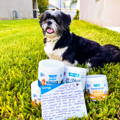Yeast Infection On Dog's Skin: Signs, Causes, & Treatment
Vet Verified
WRITTEN BY DR. JOYA GRIFFIN
Jump to Section

Yeast infections are a common but often misunderstood issue in dogs. These infections can cause discomfort for your pet and lead to more severe health problems if not addressed promptly.
So how can you tell if yeast is causing your dog’s infection? In this blog, we'll explore what a skin yeast infection is, its causes, symptoms, and the best ways to treat and prevent it.
What Is a Yeast Infection in Dogs?
A yeast infection is caused by an overgrowth of yeast, a type of fungus that naturally lives on your dog's skin. Normally, the presence of yeast is not harmful; however, when the balance is disrupted, it can multiply excessively, leading to an infection. This overgrowth often occurs in warm, moist areas, such as your dog’s ears, paws, armpits, and folds of the skin.
What Is Yeast Dermatitis or Yeast Skin Infection?
Yeast dermatitis in dogs, also known as a yeast skin infection, is a condition characterized by inflammation of the skin due to excessive yeast growth. This condition can be very uncomfortable for your dog, leading to itching, redness, and irritation. Yeast dermatitis can occur anywhere on the dog's body but is particularly common in areas that trap moisture. Recognizing and treating this condition early is essential to prevent it from getting worse.
How Is a Yeast Infection Different Than Yeast Dermatitis?
While the terms yeast infection and yeast dermatitis are often used interchangeably, there are subtle differences. A yeast infection can refer to any overgrowth of yeast on or in the body, including the ears, mouth, or digestive tract. Yeast dermatitis, on the other hand, specifically refers to the overgrowth of yeast on the skin. Understanding this distinction helps in targeting the appropriate treatment and management strategies.

Common Signs & Symptoms of Yeast Skin Problems in Dogs
Identifying the signs of yeast skin problems in dogs early can help you get timely treatment and prevent further discomfort for your companion. Common symptoms include:
- Itchy redness: Your dog may scratch or lick affected areas persistently.
- Crusty skin: Scaling or flakes (dandruff) may be present on the skin.
- Musty or unpleasant odor: A distinctive smell may emanate from the infected areas.
- Pigmentation: Darkening of the skin in affected areas.
- Thickened skin: Areas may become thicker and have a leathery or “elephant-like” appearance over time.
- Greasiness: Skin may be greasy or sticky to the touch.
Other symptoms to look out for include hair loss and frequent ear infections.
Common Causes of Dog Yeast Skin Infections
Understanding the root causes of yeast skin problems in dogs is crucial for effective treatment and prevention. Common causes include:
Underactive or Overactive Immune System
A weakened or overactive immune system can contribute to yeast infections. If a dog's immune system cannot keep the yeast in check, overgrowth occurs this can occur with hormonal disorders like hypothyroidism. An overactive immune system, like with immune-mediated skin diseases, may lead to changes in the skin which promote overgrowth of yeast.
Interaction With Allergens or Allergies
Allergies to food, environmental pollens, or flea bites can disrupt the skin's normal flora, leading to yeast overgrowth. Dogs with allergies often scratch and lick themselves, creating an ideal environment for yeast proliferation.

Poor Hygiene
Neglecting regular grooming and cleaning can lead to yeast infections on the skin in dogs. Dirty, moist environments are breeding grounds for yeast, meaning regular baths and grooming can help keep the skin clean and dry to prevent infection. Dogs with skin folds that can harbor yeast–like Basset Hounds, Pugs, and Shar Peis–may be especially prone to skin infection if they're not groomed regularly.
Poor Diet
A diet lacking in essential nutrients can weaken your dog's immune system and disrupt the balance of microorganisms on their skin. A balanced diet supports overall health, including skin health. Ingredients like omega fatty acids (found in fish oil, flaxseed, etc.) and biotin can be found in dog skin supplements, and are especially beneficial for skin barrier health.
How Are Skin Yeast Infections in Dogs Diagnosed?
Diagnosing a yeast infection on a dog's skin typically involves a physical examination and specific diagnostic tests. Your veterinarian may perform skin scrapings, tape impressions, or cytology to identify the presence of yeast. In some cases, a biopsy may be necessary.
Early diagnosis is crucial for effective treatment and to prevent complications, so discuss concerns with your veterinarian. They’ll explain the best options for your dog and let you know what to expect in regards to testing.
Treatments for Yeast Dermatitis in Dogs
Treating yeast dermatitis in dogs involves addressing the underlying cause and managing symptoms. Common treatments include:
Topical antifungal treatments
Antifungal sprays, antifungal shampoos, and antifungal creams that contain antifungal agents like Chlorhexidine can help eliminate yeast on the skin.
Oral antifungal medications
In severe cases, oral medications may be prescribed to combat the infection from within.
dietary changes
A balanced diet rich in essential nutrients supports immune health. A diet low in simple carbohydrates and glycemic foods may also be helpful since certain types of sugars and carbohydrates are friends to yeast.
regular grooming
Keeping your dog's skin clean and dry is essential in preventing and managing yeast infections. Paying special attention to cleaning folded skin areas that act as incubator areas for yeast is important.
Tips for Preventing Skin Yeast Infections in Dogs
Preventing skin dog yeast infections involves a combination of good hygiene, a balanced diet, and regular veterinary check-ups. Here are some tips:
- Regular baths: Use antifungal shampoos as recommended by your veterinarian. Pay special attention to facial folds, armpits, and any areas where the skin is folded and stays moist.
- Proper drying: Ensure your dog is thoroughly dried after baths and swimming.
- Balanced diet: Feed your dog a nutritious diet to support their immune system.
- Regular grooming: Keep your dog's coat clean and free of mats and tangles.
- Routine vet visits: Regular check-ups can help catch infections early and keep your dog healthy. If your dog is prone to chronic yeast infections, further workup will be recommended to determine the cause in order to prevent recurrence.
By following these preventive measures, you can help your dog maintain healthy skin and avoid the discomfort of yeast infections.
Understanding the signs, causes, and treatments of yeast skin problems in dogs is essential for every dog owner. With the right care and attention, you can help your furry friend stay comfortable and healthy.
Join the Pack!

Sign up for exclusive deals, curated pet tips from veterinarians, and product launches!
Pet Parents are Also Reading
May, 2024
June, 2024
August, 2022
May, 2024
Written By a Vetnique Vet

Dr. Joya Griffin, DVM, DACVD
Dr. Griffin is an expert in veterinary dermatology, with a focus on helping pets and their parents cope with fungal and immune-related skin diseases. She’s also the star of the Nat Geo WILD television series, “Pop Goes the Vet with Dr. Joya.”
Sign up for exclusive deals, curated pet tips from veterinarians, and product launches!























